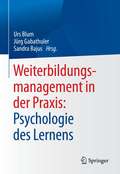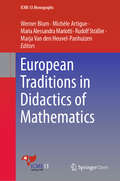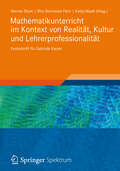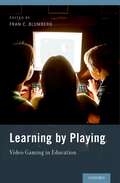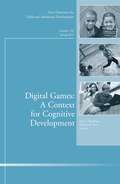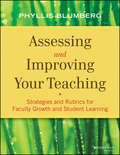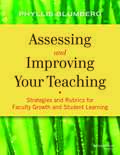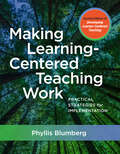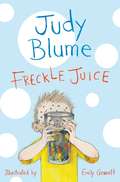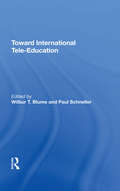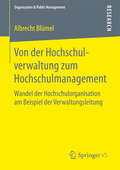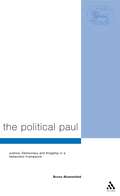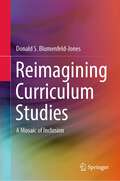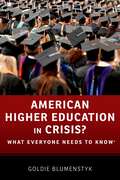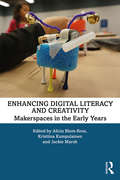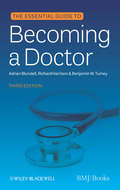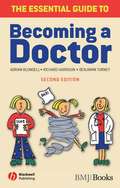- Table View
- List View
Weiterbildungsmanagement in der Praxis: Psychologie des Lernens
by Urs Blum Jürg Gabathuler Sandra BajusWie können wir - auch zukünftig - Wissen vermitteln und Mitarbeitende in ihrer Entwicklung unterstützen? In diesem Buch erfahren Sie, wie Sie bei Ihrem Weiterbildungsmanagement lernpsychologische und neurowissenschaftliche Grundlagen nutzen und Lernprozesse erfolgreich gestalten können. Neben theoretischen Grundlagen erhalten Sie direkt umsetzbare Hilfestellungen in Form von Checklisten, Tipps und Fallbeispielen. Durch die enge Verzahnung von Wissenschaft und Praxis und das didaktisch ausgereifte Konzept mit Lernzielen am jeweiligen Kapitelanfang, wichtigen Kernsätzen sowie einer Schnellleseleiste können Sie die für Sie wichtigen Inhalte rasch extrahieren. So unterstützt Sie das Buch bei Ihren aktuellen Herausforderungen von Lernen und Lehren im betrieblichen Kontext. Die Zielgruppen: Das Buch richtet sich an Praktizierende in Learning & Development, an Trainerinnen und Trainer in der betrieblichen Bildung sowie an Fachpersonen, die mit Engagement Fachwissen weitergeben. Die Herausgebenden/das Autorenteam: Die Herausgeber Urs Blum, Jürg Gabathuler und Herausgeberin Sandra Bajus leiten als Dozierende den Bereich Ausbildungsmanagement am IAP Institut für Angewandte Psychologie an der ZHAW Zürcher Hochschule für Angewandte Wissenschaften. Sie engagieren sich in Weiterbildung und Dienstleistungsmandaten für eine wirkungsvolle und praxisorientierte Personalentwicklung. Alle Mitwirkende sind erfahrene Fachpersonen aus der Praxis, mit unterschiedlichen Perspektiven und Anwendungsfeldern. Hinweis: Weitere Bände vom gleichen Herausgeberteam widmen sich im Rahmen der Reihe Weiterbildungsmanagement in der Praxis den Learning Designs sowie der strategischen Ebene der Personalentwicklung und beinhalten somit zentrale Inhalte der angewandten Psychologie für die Personalentwicklung.
European Traditions in Didactics of Mathematics (ICME-13 Monographs)
by Werner Blum Michèle Artigue Maria Alessandra Mariotti Rudolf Sträßer Marja Van den Heuvel-PanhuizenThis open access book discusses several didactic traditions in mathematics education in countries across Europe, including France, the Netherlands, Italy, Germany, the Czech and Slovakian Republics, and the Scandinavian states. It shows that while they all share common features both in the practice of learning and teaching at school and in research and development, they each have special features due to specific historical and cultural developments. The book also presents interesting historical facts about these didactic traditions, the theories and examples developed in these countries.
Mathematikunterricht im Kontext von Realität, Kultur und Lehrerprofessionalität: Festschrift für Gabriele Kaiser
by Werner Blum Rita Borromeo Ferri Katja MaaßMathematikunterricht aus verschiedenen Perspektiven zu betrachten und wissenschaftlich zu untersuchen, erweitert die Sicht auf das Lernen und Lehren von Mathematik. In dem Buch werden vier große Bereiche beleuchtet, die insbesondere die jahrzehntelangen Forschungsfelder von Gabriele Kaiser kennzeichnen: mathematisches Modellieren, sprachliche und kulturelle Einflüsse auf das Mathematiklernen, Lehrerprofessionsforschung sowie Theoriebildung in der Mathematikdidaktik. Zu diesen Bereichen haben national und international ausgewiesene Expertinnen und Experten Beiträge geleistet, um Gabriele Kaiser aus Anlass ihres 60. Geburtstags zu ehren. Das Buch enthält aktuelle Ergebnisse empirischer Untersuchungen und theoretische Perspektiven in Bezug auf einzelne Aspekte des Wirkens der Jubilarin.
Digital Games: New Directions for Child and Adolescent Development, Number 139 (J-B CAD Single Issue Child & Adolescent Development #122)
by Fran C. Blumberg Shalom M. FischIn the United States and in many other countries around the world, digital games have become an integral part of children’s lives. Discussions of research on youth and digital games often focus solely on negative effects (e.g., of violent video games), but this is far from the whole story. As natural problem-solving activities, digital games provide a rich context for applied cognition. This volume explores topics such as: The benefits of digital games for children and adolescents’ cognitive skills The nature of their learning from educational media The influence of developmental factors on their interactions with digital games The use of developmental research and established educational practice to create effective educational games that they will play. This is the 139th volume in this series. Its mission is to provide scientific and scholarly presentations on cutting edge issues and concepts in child and adolescent development. Each volume focuses on a specific new direction or research topic and is edited by experts on that topic.
Digital Games: New Directions for Child and Adolescent Development, Number 139 (J-B CAD Single Issue Child & Adolescent Development)
by Fran C. Blumberg Shalom M. FischIn the United States and in many other countries around the world, digital games have become an integral part of children’s lives. Discussions of research on youth and digital games often focus solely on negative effects (e.g., of violent video games), but this is far from the whole story. As natural problem-solving activities, digital games provide a rich context for applied cognition. This volume explores topics such as: The benefits of digital games for children and adolescents’ cognitive skills The nature of their learning from educational media The influence of developmental factors on their interactions with digital games The use of developmental research and established educational practice to create effective educational games that they will play. This is the 139th volume in this series. Its mission is to provide scientific and scholarly presentations on cutting edge issues and concepts in child and adolescent development. Each volume focuses on a specific new direction or research topic and is edited by experts on that topic.
Assessing and Improving Your Teaching: Strategies and Rubrics for Faculty Growth and Student Learning
by Phyllis BlumbergIn order to make appropriate changes to improve your teaching and your students’ learning, first you need to know how you’re teaching now. Figure it out for yourself and invigorate your teaching on your own terms! This practical evidence-based guide promotes excellence in teaching and improved student learning through self-reflection and self-assessment of one’s teaching. Phyllis Blumberg starts by reviewing the current approaches to instructor evaluation and describes their inadequacies. She then presents a new model of assessing teaching that builds upon a broader base of evidence and sources of support. This new model leads to self-assessment rubrics, which are available for download, and the book will guide you in how to use them. The book includes case studies of completed critical reflection rubrics from a variety of disciplines, including the performing and visual arts and the hard sciences, to show how they can be used in different ways and how to explore the richness of the data you’ll uncover.
Assessing and Improving Your Teaching: Strategies and Rubrics for Faculty Growth and Student Learning
by Phyllis BlumbergIn order to make appropriate changes to improve your teaching and your students’ learning, first you need to know how you’re teaching now. Figure it out for yourself and invigorate your teaching on your own terms! This practical evidence-based guide promotes excellence in teaching and improved student learning through self-reflection and self-assessment of one’s teaching. Phyllis Blumberg starts by reviewing the current approaches to instructor evaluation and describes their inadequacies. She then presents a new model of assessing teaching that builds upon a broader base of evidence and sources of support. This new model leads to self-assessment rubrics, which are available for download, and the book will guide you in how to use them. The book includes case studies of completed critical reflection rubrics from a variety of disciplines, including the performing and visual arts and the hard sciences, to show how they can be used in different ways and how to explore the richness of the data you’ll uncover.
Making Learning-Centered Teaching Work: Practical Strategies for Implementation
by Phyllis BlumbergThis is a substantially expanded and enhanced revision of Phyllis Blumberg’s acclaimed and bestselling book, Developing Learner-Centered Teaching: A Practical Guide for Faculty (Jossey-Bass, 2009).This easy to follow how-to-guide provides faculty with both a thorough introduction to this evidence-based approach to teaching and practical guidance on how to progressively implement it to strengthen the impact of their teaching. It demonstrates how they can integrate learning-centered teaching into their classroom practice without sacrificing content and rigor, and how to positively engage students in the process by demonstrating its impact on their mastery and recall of key concepts and knowledge.An added outcome, given that learning-centered teaching is correlated with improved student learning, is the resulting assessment data that it provides faculty with the measures to meet the increased demands by accreditors, legislators and society for evidence of improved teaching and learning outcomes. Phyllis Blumberg demonstrates how to use rubrics to not only satisfy outside requirements and accreditation self-studies but, more importantly, for faculty to use for the purposes of self-improvement or their teaching portfolios. She provides examples of how the rubrics can be used to ascertain whether college-wide strategic plans for teaching excellence are being met, for program review, and to determine the effectiveness of faculty development efforts. The book includes the following features: ·Boxes with easy-to-implement and adaptable examples, covering applications across disciplines and course types ·Worksheets that foster easy implementation of concepts ·Rubrics for self- assessment and peer assessment of learning-centered teaching ·Detailed directions on how to use the rubrics as a teaching assessment tool for individuals, courses, and programs ·List of examples of use classified by discipline and type of course Phyllis Blumberg offers Making Learning Centered Teaching Course Design Institutes and workshops on this and other teaching and assessment topics. Half day to multiple day modules.For more information or questions contact blumbergphyllis@gmail.com, or IntegrateEd.com
Making Learning-Centered Teaching Work: Practical Strategies for Implementation
by Phyllis BlumbergThis is a substantially expanded and enhanced revision of Phyllis Blumberg’s acclaimed and bestselling book, Developing Learner-Centered Teaching: A Practical Guide for Faculty (Jossey-Bass, 2009).This easy to follow how-to-guide provides faculty with both a thorough introduction to this evidence-based approach to teaching and practical guidance on how to progressively implement it to strengthen the impact of their teaching. It demonstrates how they can integrate learning-centered teaching into their classroom practice without sacrificing content and rigor, and how to positively engage students in the process by demonstrating its impact on their mastery and recall of key concepts and knowledge.An added outcome, given that learning-centered teaching is correlated with improved student learning, is the resulting assessment data that it provides faculty with the measures to meet the increased demands by accreditors, legislators and society for evidence of improved teaching and learning outcomes. Phyllis Blumberg demonstrates how to use rubrics to not only satisfy outside requirements and accreditation self-studies but, more importantly, for faculty to use for the purposes of self-improvement or their teaching portfolios. She provides examples of how the rubrics can be used to ascertain whether college-wide strategic plans for teaching excellence are being met, for program review, and to determine the effectiveness of faculty development efforts. The book includes the following features: ·Boxes with easy-to-implement and adaptable examples, covering applications across disciplines and course types ·Worksheets that foster easy implementation of concepts ·Rubrics for self- assessment and peer assessment of learning-centered teaching ·Detailed directions on how to use the rubrics as a teaching assessment tool for individuals, courses, and programs ·List of examples of use classified by discipline and type of course Phyllis Blumberg offers Making Learning Centered Teaching Course Design Institutes and workshops on this and other teaching and assessment topics. Half day to multiple day modules.For more information or questions contact blumbergphyllis@gmail.com, or IntegrateEd.com
Freckle Juice: The One In The Middle Is The Green Kangaroo
by Judy BlumeAndrew wants freckles. He wants to be like Nicky Lane, who has millions of them. If he had freckles like Nicky, then his mother would never notice when his neck was dirty. He wouldn't have to wash and he'd never be late for school. So when Andrew hears about the secret recipe for freckle juice, he's determined to try it . . .Freckle Juice is a humorous adventure for younger readers from literary superstar, Judy Blume, featuring inside illustrations by Kate Greenaway award-winning illustrator, Emily Gravett.
Toward International Tele-Education
by Wilbur BlumeIn the spring of 1983, concerned representatives from the communication technology, education, and government sectors gathered at a conference to explore possibilities for tele-education. This book presents their views and provides a wealth of information bearing on past, present, and future tele-education efforts. The authors in Part 1 describe gl
Toward International Tele-Education
by Wilbur BlumeIn the spring of 1983, concerned representatives from the communication technology, education, and government sectors gathered at a conference to explore possibilities for tele-education. This book presents their views and provides a wealth of information bearing on past, present, and future tele-education efforts. The authors in Part 1 describe gl
Von der Hochschulverwaltung zum Hochschulmanagement: Wandel der Hochschulorganisation am Beispiel der Verwaltungsleitung (Organization & Public Management)
by Albrecht BlümelVor dem Hintergrund umfassender Veränderungen der Leitungs- und Verwaltungsorganisation an deutschen Hochschulen geht Albrecht Blümel der Frage nach, wie sich die institutionellen Besonderheiten der Verwaltungsleitung und das berufliche Profil von Kanzlern und Kanzlerinnen an deutschen Hochschulen entwickelt haben. Anhand von Analysen der historischen Genese und der rechtlichen Veränderungen der formalen Stellung der Verwaltungsleitung sowie einer deutschlandweiten Befragung von Kanzlern und Kanzlerinnen verdeutlicht der Autor den Wandel von einer akademisch-bürokratischen Logik der Hochschulverwaltung zu einer post-bürokratischen Logik des Hochschulmanagements.
The Political Paul: Democracy and Kingship in Paul's Thought (The Library of New Testament Studies)
by Bruno BlumenfeldThe Political Paul presents Paul as a political thinker. Many studies claiming Paul for Greek Hellenism discuss the influence upon him of various aspects of Hellenistic culture, but strangely neglect Hellenistic political philosophy with its roots in Classical antiquity. The Political Paul explores this dimension of PaulÆs thought within the general context of Hellenistic political reflection to focus on the intriguing body of literature known as the Pythagorean pseudepigrapha. These researches support the highly original argument that Christianity has foundations in Hellenistic kingship theories. Paul constructs a political theory for Christianity. He conceives it as a polis-basileia system, politics proper and divine rule, each with its own dikaiosyne; this the study re-evaluates as a political concept.
Reimagining Curriculum Studies: A Mosaic of Inclusion
by Donald S. Blumenfeld-JonesThis book addresses the crucial issue of how we value and deploy the idea of “freedom” that underlies contemporary curriculum studies. Whether we are conventional curriculum thinkers who value knowledge development or favor a Deweyan, individualist orientation toward curriculum or are a critical social justice curriculum thinker, at the heart of all these orientations and theorizing is the value of “freedom.” The book addresses “freedom” through novel sources: the work of Martin Buber on education, Julia Kristeva on the uses of imagination and the female/male dialectic, Emmanuel Levinas’ unique approach to ethics, and more. Readers will find new ways to understand freedom and the world of ethical life as informing curriculum thinking. It provides a more ecumenical vision that can draw our differences together. It helps readers to reconsider ourselves in fruitful ways that can bring more relevance and substance to the field.
American Higher Education in Crisis?: What Everyone Needs to Know® (What Everyone Needs To Know®)
by Goldie BlumenstykAmerican higher education is at a crossroads. Technological innovations and disruptive market forces are buffeting colleges and universities at the very time their financial structure grows increasingly fragile. Disinvestment by states has driven up tuition prices at public colleges, and student debt has reached a startling record-high of one trillion dollars. Cost-minded students and their families--and the public at large--are questioning the worth of a college education, even as study after study shows how important it is to economic and social mobility. And as elite institutions trim financial aid and change other business practices in search of more sustainable business models, racial and economic stratification in American higher education is only growing. In American Higher Education in Crisis?: What Everyone Needs to Know, Goldie Blumenstyk, who has been reporting on higher education trends for 25 years, guides readers through the forces and trends that have brought the education system to this point, and highlights some of the ways they will reshape America's colleges in the years to come. Blumenstyk hones in on debates over the value of post-secondary education, problems of affordability, and concerns about the growing economic divide. Fewer and fewer people can afford the constantly increasing tuition price of college, Blumenstyk shows, and yet college graduates in the United States now earn on average twice as much as those with only a high-school education. She also discusses faculty tenure and growing administrative bureaucracies on campuses; considers new demands for accountability such as those reflected in the U.S. Department of Education's College Scorecard; and questions how the money chase in big-time college athletics, revelations about colleges falsifying rankings data, and corporate-style presidential salaries have soured public perception. Higher education is facing a serious set of challenges, but solutions have also begun to emerge. Blumenstyk highlights how institutions are responding to the rise of alternative-educational opportunities and the new academic and business models that are appearing, and considers how the Obama administration and public organizations are working to address questions of affordability, diversity, and academic integrity. She addresses some of the advances in technology colleges are employing to attract and retain students; outlines emerging competency-based programs that are reshaping conceptions of a college degree, and offers readers a look at promising innovations that could alter the higher education landscape in the near future. An extremely timely and focused look at this embattled and evolving arena, this primer emphasizes how open-ended the conversation about higher education's future remains, and illuminates how big the stakes are for students, colleges, and the nation.
American Higher Education in Crisis?: What Everyone Needs to Know® (What Everyone Needs To Know®)
by Goldie BlumenstykAmerican higher education is at a crossroads. Technological innovations and disruptive market forces are buffeting colleges and universities at the very time their financial structure grows increasingly fragile. Disinvestment by states has driven up tuition prices at public colleges, and student debt has reached a startling record-high of one trillion dollars. Cost-minded students and their families--and the public at large--are questioning the worth of a college education, even as study after study shows how important it is to economic and social mobility. And as elite institutions trim financial aid and change other business practices in search of more sustainable business models, racial and economic stratification in American higher education is only growing. In American Higher Education in Crisis?: What Everyone Needs to Know, Goldie Blumenstyk, who has been reporting on higher education trends for 25 years, guides readers through the forces and trends that have brought the education system to this point, and highlights some of the ways they will reshape America's colleges in the years to come. Blumenstyk hones in on debates over the value of post-secondary education, problems of affordability, and concerns about the growing economic divide. Fewer and fewer people can afford the constantly increasing tuition price of college, Blumenstyk shows, and yet college graduates in the United States now earn on average twice as much as those with only a high-school education. She also discusses faculty tenure and growing administrative bureaucracies on campuses; considers new demands for accountability such as those reflected in the U.S. Department of Education's College Scorecard; and questions how the money chase in big-time college athletics, revelations about colleges falsifying rankings data, and corporate-style presidential salaries have soured public perception. Higher education is facing a serious set of challenges, but solutions have also begun to emerge. Blumenstyk highlights how institutions are responding to the rise of alternative-educational opportunities and the new academic and business models that are appearing, and considers how the Obama administration and public organizations are working to address questions of affordability, diversity, and academic integrity. She addresses some of the advances in technology colleges are employing to attract and retain students; outlines emerging competency-based programs that are reshaping conceptions of a college degree, and offers readers a look at promising innovations that could alter the higher education landscape in the near future. An extremely timely and focused look at this embattled and evolving arena, this primer emphasizes how open-ended the conversation about higher education's future remains, and illuminates how big the stakes are for students, colleges, and the nation.
Career Journeys of Diverse Leaders in Higher Education: Climbing the Rough Side of the Mountain
by George Blumenthal Josefina Castillo Baltodano Currie, Ding-Jo H.This book provides a study of diverse leadership development through the extraordinary journeys of ten retired presidents and chancellors who have left an indelible impact on higher education.Representing a rich multicultural background, each chapter tells a personal story of transformation and triumph, highlighting the various, non-traditional paths to senior leadership. Hailing from both private and public, two- and four-year institutions across the United States, these trailblazers showcase that excellence knows no bounds. Contributors reflect on the struggles and engagements with racialized ethnic realities and growing awareness of gender inequities. Discussion questions supply rich ground for meaningful engagement in book clubs, leadership classes, workshops, and institutes, prompting readers to plumb the depths of their own experiences in confronting justice, equity, and inclusion.Filled with captivating narratives touching on the common threads of shared values and invaluable life lessons that weave through diverse experiences, this book is a testament to the power of inspiration and motivation for those considering or dismissing their aspirations to achieve leadership roles in higher education.
Career Journeys of Diverse Leaders in Higher Education: Climbing the Rough Side of the Mountain
by George Blumenthal Josefina Castillo Baltodano Ding-Jo H. CurrieThis book provides a study of diverse leadership development through the extraordinary journeys of ten retired presidents and chancellors who have left an indelible impact on higher education.Representing a rich multicultural background, each chapter tells a personal story of transformation and triumph, highlighting the various, non-traditional paths to senior leadership. Hailing from both private and public, two- and four-year institutions across the United States, these trailblazers showcase that excellence knows no bounds. Contributors reflect on the struggles and engagements with racialized ethnic realities and growing awareness of gender inequities. Discussion questions supply rich ground for meaningful engagement in book clubs, leadership classes, workshops, and institutes, prompting readers to plumb the depths of their own experiences in confronting justice, equity, and inclusion.Filled with captivating narratives touching on the common threads of shared values and invaluable life lessons that weave through diverse experiences, this book is a testament to the power of inspiration and motivation for those considering or dismissing their aspirations to achieve leadership roles in higher education.
Enhancing Digital Literacy and Creativity: Makerspaces in the Early Years
by Alicia Blum-Ross Kristiina Kumpulainen Jackie MarshEnhancing Digital Literacy and Creativity is an exploration of how young children gain digital literacies in ‘makerspaces.’ The international authors investigate how hands-on experimentation with a variety of materials - from traditional arts and crafts to contemporary digital tools like 3D printers and laser cutters - can aid children in their development of play, creativity and storytelling. From museums to libraries, nursery schools to community centres, this research shows how ‘making’ supports the development of creative skills and introduces concepts to be explored in a variety of environments and contexts. Drawing on examples from around the globe, described by a range of international academics, Enhancing Digital Literacy and Creativity includes chapters on: Virtual reality Museum and library makerspaces Intergenerational making in families Making in schools and nursery settings Assessing learning in makerspaces Links to previous theories Social imagination This book will be a valuable resource for students and researchers in the fields of education and digital literacies; early childhood teacher educators and practitioners; librarians; museum educators; and makerspace staff.
Enhancing Digital Literacy and Creativity: Makerspaces in the Early Years
by Alicia Blum-Ross Kristiina Kumpulainen Jackie MarshEnhancing Digital Literacy and Creativity is an exploration of how young children gain digital literacies in ‘makerspaces.’ The international authors investigate how hands-on experimentation with a variety of materials - from traditional arts and crafts to contemporary digital tools like 3D printers and laser cutters - can aid children in their development of play, creativity and storytelling. From museums to libraries, nursery schools to community centres, this research shows how ‘making’ supports the development of creative skills and introduces concepts to be explored in a variety of environments and contexts. Drawing on examples from around the globe, described by a range of international academics, Enhancing Digital Literacy and Creativity includes chapters on: Virtual reality Museum and library makerspaces Intergenerational making in families Making in schools and nursery settings Assessing learning in makerspaces Links to previous theories Social imagination This book will be a valuable resource for students and researchers in the fields of education and digital literacies; early childhood teacher educators and practitioners; librarians; museum educators; and makerspace staff.
The Essential Guide to Becoming a Doctor
by Adrian Blundell Richard Harrison Benjamin W. TurneyAll you need to know about becoming a doctor in the UK This book contains all the help you need to become a doctor. From applying to medical school through to choosing your specialty, you can find out: How to choose a medical school How to get into medical school How to survive as a medical student All about electives What life is like as a doctor As well as easy to follow information on choosing, getting into - and surviving - medical school, junior doctors in different specialties provide unique insight with firsthand accounts of what the job is like in real life, to help you plan and decide your future career path. Included in this fully updated third edition is the latest information on admission tests, an admission table with practical details about each medical school (as well as greater coverage of graduate medical schools), making this now even more comprehensive for everyone planning a career in medicine.
The Essential Guide to Becoming a Doctor
by Adrian Blundell Richard Harrison Benjamin W. TurneyAll you need to know about becoming a doctor in the UK This book contains all the help you need to become a doctor. From applying to medical school through to choosing your specialty, you can find out: How to choose a medical school How to get into medical school How to survive as a medical student All about electives What life is like as a doctor As well as easy to follow information on choosing, getting into - and surviving - medical school, junior doctors in different specialties provide unique insight with firsthand accounts of what the job is like in real life, to help you plan and decide your future career path. Included in this fully updated third edition is the latest information on admission tests, an admission table with practical details about each medical school (as well as greater coverage of graduate medical schools), making this now even more comprehensive for everyone planning a career in medicine.
The Essential Guide to Becoming a Doctor
by Adrian Blundell Richard Harrison Benjamin W. TurneyAn informative guide for anyone contemplating a career in medicine. Up-to-date, essential information for a wide group of school leavers Covers getting to medical school, being there and life thereafter Written by newly qualified doctors who lecture on medical careers
